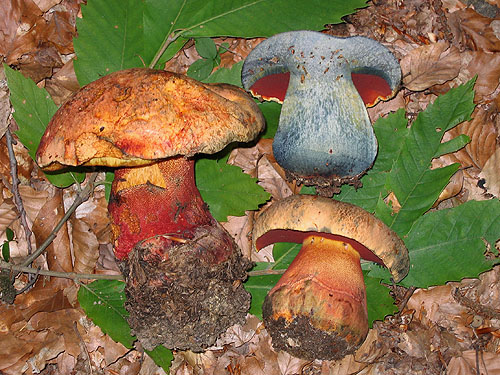Boletus L.
Recent molecular studies have shown that Boletus in its current circumscription is likely an artificial grouping and it is possible that it will be split at some point into smaller genera. Note that Boletus impolitus and Boletus depilatus for practical reasons are retained here, although there is strong evidence that they are closely related to Xerocomus subtomentosus and its allies.
Fruitbody large to medium sized, boletoid, without veil and ring. Stipe solid, with surface usually covered with granules or network. Flesh variously coloured, changing or not when exposed to air. Tubes easily separable from each other, not tearing apart. Pores usually small and rounded.
Boletus luteocupreus Bertèa & Estadés
Description
Cap up to 12 cm, at first hemispherical, later convex, pastel yellow, pale yellow to pale orange, spoted light orange, dark orange or reddish orange, velvety then more or less smooth, strongly blueing when bruised. Stipe swolen or obese, pastel yellow, light yellow to vivid yellow, covered with dense very fine orange red or scarlet red network; stipe surface blueing strongly at the slightest touch. Flesh firm and very dense, lemon yellow, sometimes red in the stipe base, blueing instatly when exposed to the air then fading in half an hour and then changing to dingy orange red. Tubes, yellow, bluing when exposed to air. Pores bright red, occasionally orange red nearly the cap margin, blue-black when bruised. Smell not distinctive. Taste rather acid. Spores 12–18.5 × 5.5 μm, ratio 2.2–3.5. Pileipellis (the cap cuticle) a trichoderm of septate hyphae of long cylindrical cells. Chemical reactions: hyphae of the flesh at the stipe base inamyloid with Melzer’s reagent.
Habitat. Warm deciduous forests, mycorrhizal with oaks (Quercus) and sweet chestnut (Castanea).
Distribution. More or less southern species that might be under-recorded. So far known from Bulgaria, Corsica, France, Germany, Italy, Spain and Switzerland. Possibly seen in Greece (see Κωνσταντινίδης 2009). At least part of the Hungarian records of Boletus torosus also belong here (see illustration in Károly 2009). Recently spotted also in Slovakia (see photographs here) but no published records are known from this country yet.
Similarity. Similar to B. rhodopurpureus, which has differently coloured cap. Might be confused with B. torosus, but the later has cap with more or less developed olivaceous tint and yellow pores.
Photographs

Fruitbodies of Boletus luteocupreus. (photo B. Assyov)

Young fruitbody of Boletus luteocupreus. (photo B. Assyov)

Fruitbody of Boletus luteocupreus (photo B. Assyov)
Important literature
Assyov, B. 2005. New and rare Bulgarian boletes. – Mycologia Balcanica 2: 75–81. (available online)
Bertéa, P. & Estadès, A. 1990. Boletus luteocupreus sp. nov. – Documents Mycologique 20(78): 10.
Bertéa, P., Estadès, A. & Redeuilh, G. 1991. Sur la validité et la légitimité de Boletus luteocupreus Bertéa et Estadè s. – Documents Mycologique 21(82): 7–8.
Breitenbach J. & Kränzlin F. 1991. Pilze der Schweiz. Bd. 3(1). Röhrlinge und Blätterpilze. Verlag Mykologia, Luzern.
Estadès, A. & Lannoy, G. 2004. Les bolets européens. – Bulletin Mycologique et Botanique Dauphiné-Savoie 44(3): 3–79.
Galli, R. 1998. I Boleti. Atlante pratico-monographico per la determinazione dei boleti. Edinatura, Milano.
Károly, E. 2009. Sárospatak környéki nagygombák fungisztikai, ökológiai és természetvédelmi jellemzése. PhD thesis. Corvinus University of Budapest, Budapest. (available online)
Lannoy, G. & Estadès, A. 2001. Les Bolets. Flore mycologique d’Europe. Documents Mycologiques Mémoire Hors série no. 6. Pp. 1–163. Association d’Écologie et de Mycologie, Lille.
Martinelli, G. & Senn-Irlet, B. 2008. Boletus luteocupreus – Der Gelbhütige Purpurröhrling aus der Schweiz. – Schweizerische Zeischrift für Pilzkunde 86: 91–94.
Muñoz, J.A. 2005. Boletus s. l. – In: Fungi Europaei. Vol. 1. Pp. 1–951. Edizioni Candusso, Alassio.
Schreiner, J. 1997. Boletus luteocupreus Bertéa & Estadès, Gelbhütiger Purpurröhrling, Erstnachweis für Deutschland. – Mycologia Bavarica 2: 2–11.
Simonini, G. 1995. I Boleti della sezione Luridi a viraggio violento: problemi tassonomici. – Mycologia e Vegetazione Mediterranea 10: 88–112.
Κωνσταντινίδης, Γ. 2009. Μανιτάρια, φωτογραφικός οδηγός μανιταροσυλλέκτη. Αυτοέκδοση, Αθήνα. [Konstantinidis, G. 2009. Mushrooms, a photographic guide for collectors. Published by the author, Athens.]